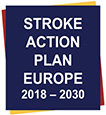
Seven Domains
The Stroke Action Plan for Europe builds on two previous pan-European consensus meetings, the 1995 and 2006 Helsingborg meetings, which were convened to review the scientific evidence and the state of current services, and to set targets for the development of stroke care for the decade to follow.
The SAP-E adheres to the format of the Helsingborg Declarations, presenting a review of the “state of the art”, the state of current services, research and development priorities, and targets for the main domains in stroke care: Primary Prevention, Organisation of Stroke Services, Acute Stroke Management, Secondary Prevention, Rehabilitation, Evaluation of Stroke Outcome and Quality Assessment, and Life After Stroke.

Prioritised research areas
In addition to the seven domains, improvement projects and implementation initiatives should also focus on research activities.
Clinical discoveries have resulted in huge improvements in the management and treatment of acute ischaemic stroke patients. There have been advances in understanding the pathophysiology of stroke and chronic cerebrovascular diseases1, but the goal of translating this knowledge into successful treatments has not been achieved.
Bridging the ‘translational gap’ between basic and clinical stroke research is critical for the development of effective treatments.
Commitment is needed from EU and national funding agencies to invest in stroke research in a proportionate manner to the magnitude and prevalence of the health problem. Strategies designed to validate findings from exploratory research require a joint effort that exceeds the capacity of individual projects or small sporadic collaborative endeavours.
Strong independent institutional support is required to make the transition from classical designs to a novel concept of organised research structures and data validation that aims to facilitate reliable translation of preclinical findings to clinical practice.
The pharmaceutical industry should also be engaged in this process: involvement of pharmaceutical companies could be increased by facilitating exchanges between academic and pharmaceutical research at the point of transition from exploratory to confirmatory preclinical studies. Finally, researchers must disseminate their findings to bring stroke research closer to patient associations and the general population.
References
1. Demuth HU, Dijkhuizen RM, Farr TD, et al. Recent progress in translational research on neurovascular and neurodegenerative disorders. Restor Neurol Neurosci 2017; 35: 87–103.


